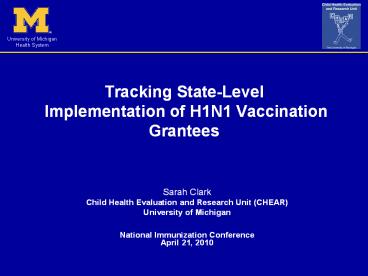Tracking State-Level Implementation of H1N1 Vaccination Grantees PowerPoint PPT Presentation
1 / 12
Title: Tracking State-Level Implementation of H1N1 Vaccination Grantees
1
Tracking State-Level Implementation of H1N1
Vaccination Grantees
- Sarah Clark
- Child Health Evaluation and Research Unit (CHEAR)
- University of Michigan
- National Immunization Conference
- April 21, 2010
2
Background
- H1N1 vaccine implementation was characterized by
- Federal guidance and structure
- Flexible implementation at the program level
- No existing mechanism to track implementation
across states
3
Background
- UM team collected situational awareness data on
H1N1 vaccine implementation - September 2009 February 2010
- Collaborative approach
- Short-term feedback
- Lessons learned based on experiences
4
Purpose
- To describe some of the key influences on state
implementation of H1N1 vaccination
5
Key Influences
- States had varying goals for their H1N1 vaccine
campaigns - Make vaccine available to whoever wants it.
- Vaccinate as many people as possible.
- Vaccinate high-risk individuals first.
- Goals established the perspective for key
decisions
6
Key Influences
- State immunization officials had varying
relationships with other key agencies prior to
H1N1 - Preparedness
- Epidemiology
- Education
- Medical licensure
7
Key Influences
- States have varying public health capacity
- Almost no public health departments
- City/county/regional health departments that are
agents of the state - City/county/regional health departments that are
autonomous - Range of LPH 1 to 350
- Variety of service delivery across LPH
8
Key Influences
- States began the campaign with variable
information infrastructure - Immunization information systems
- Databases of providers
- Communication systems
- States had variable IT support
- New mechanisms needed for registration,
allocation, doses administered reporting
9
Key Influences
- States were highly variable in their existing
relationships with other immunization providers
and settings - Hospitals
- Adult immunization providers
- Pharmacies and community vaccinators
- Schools
10
Lessons Learned
- Flexibility in implementation of H1N1 vaccination
was essential to - accommodate existing state differences
- allow for different choices
- States should build on their H1N1 efforts
- New relationships with providers and other state
agencies - Information systems
11
Acknowledgments
- University of Michigan team Anne Cowan, Brian
Macilvain, Gary Freed - AIM Claire Hannan, Katelyn Wells
- Immunization program officials
12

